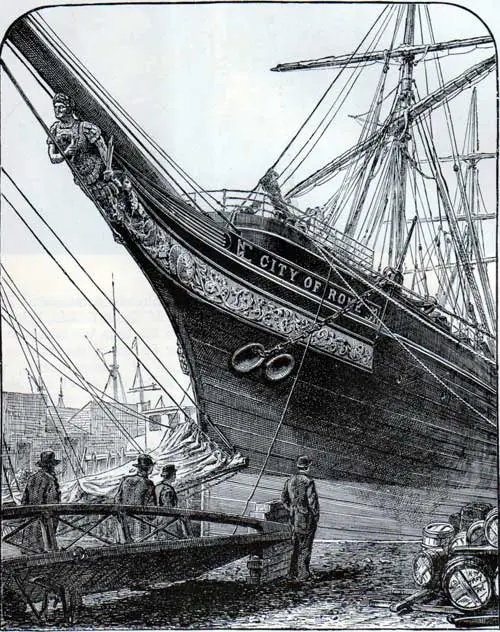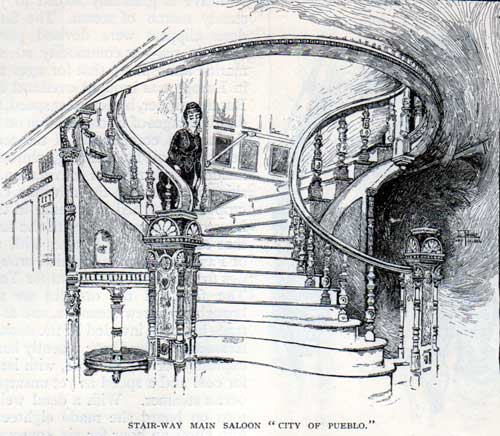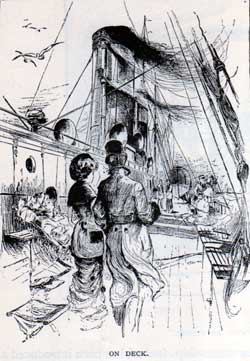Passenger Comforts and Accommodations 1882
Ocean Steamships Article by S. G. W. Benjamin - Part 4
The disadvantage of carrying them against a head wind amounts to very little in a long voyage and is fully counterbalanced in the long run by the advantage gained when the wind is favorable. No ocean steamship should be permitted to go to sea without canvas; at least no passenger ship; it is a penny-wise economy which leads a company to dispense with it.

Bow of the City of Rome
The ventilation of ocean steamships is a question of great importance, and one which is taxing the ingenuity of the sanitarian. On American coasting steamers this has received much attention. Their smaller size and greater proportionate beam make the general problem easier, and enables them also to carry a number of airy state-rooms in their deck houses.
But when it comes to a ship having accommodations for 2000 people, the problem is not an easy one, for in such a vessel there are many dark nooks and narrow, winding passages, and in stormy weather many of the windows must be closed, partly as a matter of safety. Complaint is made sometimes on this score by passengers, who forget that, while some may like to sit in a draft, there are others to whom it is excessively uncomfortable, not to say dangerous, to do so, and that a ship is not like a house on shore, but is subject to conditions involving constant regard to security.

Stairway of the Main Saloon - City of Pueblo
The best staterooms in ocean steamships are now thoroughly ventilated. If passengers insist on being the last to secure good state-rooms in crowded ships or on paying second-class fare, they must not complain if they are served as they would be under similar circumstances at a hotel, in which it is manifestly impossible that all the rooms should be equally advantageous.
The fact is, while the competition in passenger travel exists as it does now, steamship companies are obliged to offer every possible comfort to the traveler. Some passengers are so unreasonable that they are almost inclined to blame the ship itself because it does not keep on an even keel in a heavy sea. The question of ventilation has been most thoroughly studied in the steamships going to the tropics, in which every appliance is brought into action to withstand the heat. The sides of the staterooms are made of open slats arranged as in a blind and affording unobstructed circulation of air throughout the cabin.
This, I well remember, proved a source of discomfort to me when going northward in one of the South African steamers. As we drew near Europe and met the colder air of the North Atlantic, the circulation of air over the berth was far from agreeable, and I was forced to hang blankets against the slat partition.
In the new steamship Austral, has been introduced a novel plan for cabins throughout, intended to secure direct ventilation to each state-room, even in the heaviest weather. The state-rooms have a protected passage-way four feet wide running completely around them fore and aft. This passage is also carried across the vessel at frequent intervals. Each state-room is thus provided with large windows instead of the small, round bull's-eyes or dead-lights which must be closed in stormy weather.
The outer port-holes, admitting the fresh air, always can be open, as the water can never penetrate to the state-room. This principle is undoubtedly destined to be widely adopted. The main saloon is cooled by a revolving fan moved by steam. This ship has been wisely provided with abundant canvas, and is in other respects well arranged for passenger and freight traffic.

Passengers stroll on Deck during calmer weather
Another improvement, first introduced, we believe, on the Germanic-, is the system of turning chairs at the dining tables. The passenger can by this means leave the table at his own convenience without incommoding others. The Alexandre line has introduced another improvement, in such ships as the City of Pueblo. The saloon is provided with small tables, as in a restaurant.
The passenger is not obliged to eat with a crowd of strangers, but selects his own time for meals, paying only for what he orders. Many other conveniences are to be found on the passenger vessels of our time, such as bath-rooms, barber's shops, swinging couches, smoking-rooms, social halls, electric bells, and so forth. The application of steam to navigation is on the increase.
The reduced expense of steam is leading to the employment of steamers in lines of trade which it has been supposed until recently must for a long period yet be carried on by sailing ships. The stanch conservative is gradually forced to yield to the steady march of steam.
The famous Aberdeen clippers were devised partly for the trade in tea -- a commodity so sensitive to marine atmosphere that for ages the best tea in Europe was brought overland from China. But the clipper, by her great speed, reduced the disadvantages of transportation on the sea, and the annual competition of the tea ships has been one of the stirring, almost romantic, incidents of modern navigation.
The first ship to arrive with the advance cargo of the crop was crowned with fame in the shipping houses. So also was it with the first schooner that arrived in the Thames with the oranges of Fayal, and the bark which brought the first figs from Smyrna in season for Thanksgiving. The figs and the oranges are now largely brought by screw steamers, and at last the tea trade has been invaded by the steamship.
The steamer Stirling Castle recently has been built expressly for this purpose, with large capacity for coal and a. speed as yet unsurpassed by an ocean steamer. With a dead weight of 3000 tons on board she made eighteen and one-fifth knots an hour for six consecutive hours. She is built of steel, and registers 4300 tons.
